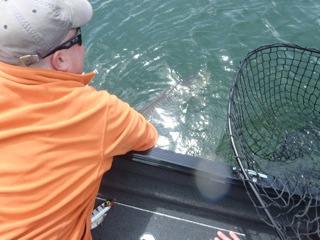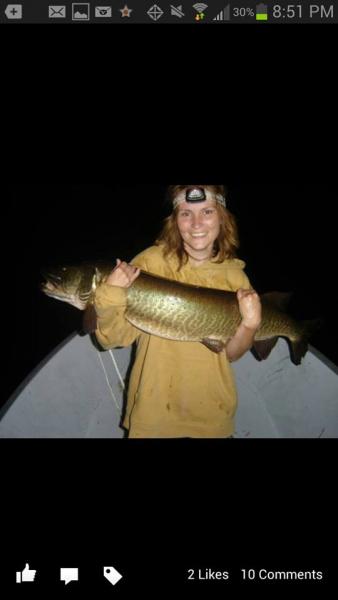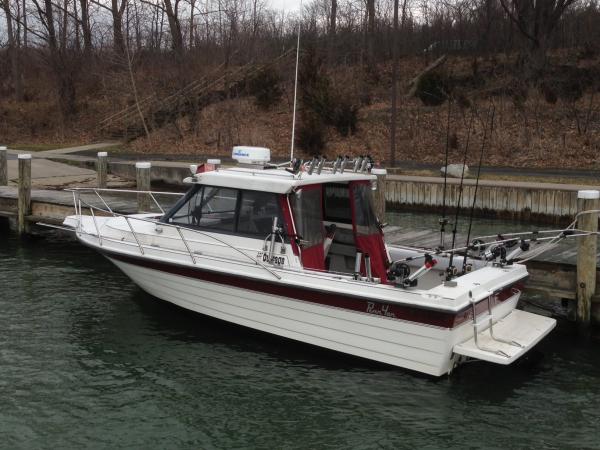-
Posts
2,315 -
Joined
-
Last visited
Content Type
Profiles
Forums
Events
Gallery
Store
Everything posted by mostlymuskies
-

Otisco Tiger Musky Tournament - May 11
mostlymuskies replied to NitroMusky's topic in Musky, Tiger Musky & Pike (ESOX)
-
Navtronics App for your Andriod or I phone.Cost $14.95 and you can do everything you can do on your gps chart plotter.
-
There were close to 250 kids and parents today at the Bison City Rod & Gun Club Jimmy Griffin Kids Day.The fishing was a little slow, water was still 40 degrees, only 6 fish were caught.1st place went to a 4 year old girl who caught a 10" perch.A good number of boys & girls went home with free rods & reels, all went home with free lures etc.. I would personaly like to thank Dave Barus for all he does to promote kids fishing.
-

Musky Fishing Cave Run Lake PMTT 2013
mostlymuskies replied to BlueEye's topic in Musky, Tiger Musky & Pike (ESOX)
I would bet over half of the guys entered in the PMTT Cave Run Event went fishless.Some of those guys are some of the best muskie fishernen in the country as well.So in reality to place a muskie on the board under the fishing conditions that has been slow there for a couple weeks shows that you guys are very good fishermen and represented Western New York well! Winning the event is what everyone would like to do, but congrads on a good showing, remember always that you placed in the top of the field.Have a safe drive home! -
-

Musky Fishing Cave Run Lake PMTT 2013
mostlymuskies replied to BlueEye's topic in Musky, Tiger Musky & Pike (ESOX)
-

Musky Fishing Cave Run Lake PMTT 2013
mostlymuskies replied to BlueEye's topic in Musky, Tiger Musky & Pike (ESOX)
-
Myself,Chuck Bataglia & Chip Spiesman are the Chautauqua County Federation of Sportsmans Clubs delegates to stay on top of the Chautauqua Lake SAVMP / Chemical Weed Control Plan.We will start by looking at what Chemical they want to use if they are given a permit to do so.We will look at the permit process and find out if there should be a eviromental impack study on a very small area of weeds over a period of time.We will keep pushing for selective cutting,with no chemicals used.
-

Musky Fishing Cave Run Lake PMTT 2013
mostlymuskies replied to BlueEye's topic in Musky, Tiger Musky & Pike (ESOX)
-

Musky Fishing Cave Run Lake PMTT 2013
mostlymuskies replied to BlueEye's topic in Musky, Tiger Musky & Pike (ESOX)
-

FYI.....Deal on sunglasses from a local business
mostlymuskies replied to Yankee Troller's topic in Open Lake Discussion
Yes, best when you go to the small optician and you get one on one carring service.If you need prescription sunglasses you get the correct lenses, not a factory close lense that some big stores will fit you with to save costs out of their pocket.I'm lucky, my wife is an optician and I get Wiley X Sunglasses with 98 percent polarization, no glare & scratch resistant coatings for free, normal cost over $400. -

Pike spawning on Conesus Lake
mostlymuskies replied to Scott2314's topic in Musky, Tiger Musky & Pike (ESOX)
Maybe inbetween at 38" Sizelimit with Creel Limit of 2,I will bring this up with NYSDEC Region 8 at the May NY Muskies 69 Meeting.Brad Hammers, a fisheries biologist with the DEC’s Region 8 will be in to provide information and updates on the Southern tier muskie fisheries including Waneta lake; as well as the DEC’s activities and plans for Waneta and Lamoka lakes the future. Yes, you heard that right: we said Lamoka lake too! Come down to the meeting and get the drop on what this is all about and join the discussion on MI-NY’s potential involvement. We hope to see you there! -
Congressman Chris Collins (NY-27) has announced that the long awaited dredging of three Lake Ontario harbours is on track to happen next year. Collins says the Army Corp of Engineers now has the funding it needs to perform maintenance dredging in Oak Orchard, Olcott and Wilson harbours. “The dredging of these three local harbours is long overdue,†said Collins. “Local residents and government leaders have been pushing the federal government to prioritize the work in order to maintain and maximize the harbours’ economic and recreational importance. "These waterways are not only used for summer boating and recreation, but play a critical role in supporting the regional economy through the charter fishing industry. "As a new member of Congress, I will push to make sure this long delayed work finally happens in the summer of 2014.†According to the US Army Corps of Engineers: • Oak Orchard Harbour (Town of Carlton, Orleans County) was last dredged in 2004 when 10,700 cubic yards (CY) of material was removed. This harbour should be dredged every three to five years. In order to maintain adequate channel depth, 18,000 CY of dredging will be required. The total sediment backlog is estimated at approximately 35,000 CY. • Olcott Harbour (Village of Olcott, Niagara County) was last dredged in 1997 when 9,900 cubic yards (CY) of material was removed. This harbour should be dredged every five to ten years. The current sediment backlog is estimated at approximately 55,000 CY. • Wilson Harbour (Town of Wilson, Niagara County) was last dredged in 2000 when 5,100 cubic yards (CY) of material was removed. This harbour should be dredged every three to five years. The current sediment backlog is estimated at approximately 55,000 CY. Collins is co-sponsoring the Realize America’s Maritime Promise Act or RAMP Act (H.R. 335) which would help ensure the funding is in place for routine maintenance dredging. This bipartisan legislation guarantees that the funds collected on imports at ports in the United States is used solely for its intended purposed of dredging and maintaining US waterways. State Senator George Maziarz (R-C, Newfane) said, “I represent more than 50 miles of Lake Ontario shoreline and can attest that the state of our harbours has been a significant concern for many years. Finding federal dollars to dredge our key harbours for improved boater access has been a critical need for our waterfront communities. I commend Congressman Collins for his attention to the problem and his progress in securing the necessary funding resources.†Congressman Collins is also supporting continued funding for the Great Lakes Restoration Initiative. The inter-agency programme helps to protect and preserve the Great Lakes ecosystem. The Great Lakes are the source of drinking water for 30 million Americans, and hold 95 percent of our nation’s supply of fresh water. Collins’ congressional district is bordered by Lake Erie to the west and Lake Ontario to the north. More articles from this category Finally!!!
-
-
Will Chautauqua End Up Like Lake Arthur? Decline in Lake Arthur muskellunge fishing has anglers, state trolling for answers Sunday, October 09, 2011 By John Hayes, Pittsburgh Post-Gazette Pennsylvania Fish and Boat Commission Fisheries biologist aide Matt Gordon holds a 50-inch muskie during a 2011 survey of Lake Arthur. PORTERSVILLE -- The waters of Lake Arthur were calm Monday evening. But in a meeting room at Mount Zion Baptist Church, on the shoreline of Shannon Run Bay, a maelstrom of controversy swirled as anglers, the state Fish and Boat Commission and Moraine State Park management clashed over what's happening beneath the surface. The 3,225-acre Lake Arthur impoundment has long been considered one of Pennsylvania's premiere muskie lakes, stocked yearly by the state with 3,300 young muskies averaging 6 inches. Survival rates are low, but good forage, a stable weed mass for cover and catch-and-release practices resulted in higher than normal catch rates for what has been called the "fish of 10,000 casts." But in recent years, anglers have noticed a decline in catches. In a routine survey this summer, Fish and Boat biologists found lots of muskies at Lake Arthur, particularly big ones, but were startled to log a total absence of entire year classes of muskies, those from 26 to 32 inches. No doubt something is changing at Lake Arthur. The mystery grows as anglers and the agencies that maintain the lake spar over what's to blame for the missing muskies. At last week's meeting, members of the Moraine Muskie Association presented enterprising informal research they believe shows the impacts of aquatic herbicides used to control weed growth at the lake. Tim Wilson, the Fish and Boat biologist who manages the Lake Arthur fishery, shared research that confirmed some of the anglers' concerns but challenged their conclusions. Following the meeting, park manager Dan Bickel defended the use of herbicides to control the plants, and inferred possible linkage to Moraine's ongoing problems with municipal sewage processed by the park. Herbicides "We've noticed a sharp decline in muskie numbers in Lake Arthur. Probably four years ago it started," said Fombell muskie guide and Moraine Muskie member Howard Wagner. "We wanted to see the effects of herbicide use on places we knew had good weed beds, so we went from bay to bay. Portersville Bay, Bear Run, Osprey, under the Route 528 bridge, the five fingers including Muddy Creek Bay -- wherever we went, we found no weeds or poor weed growth." The group's main concern is the park's use of two aquatic herbicides (trade names Reward and Navigate) to clear the water for boaters. Group members presented photos of de-weeded areas and charts comparing muskie stocking rates and harvest reports. Some feared muskies were directly poisoned by herbicides; others were convinced the weed-control policy destroys habitat for forage fish. Since Moraine State Park opened in 1971, the state Department of Conservation and Natural Resources has used Reward and Navigate to clear weeds from the swimming beach, 10 boat launches, marinas and other areas. "We have to manage for multiple uses -- fishing, swimming, pontoon boats, sail boats, canoes and kayaks, hydrofoils," said Bickel. "We had a lot of complaints from the marina this year from people having trouble getting out of their slip spaces due to aquatic weed growth. . . . When we use it, we use the minimum amount of herbicide that we possibly can." Since 1971, DCNR has treated as many as 43 acres of Lake Arthur per year, at 1 gallon per acre, depending upon need. In 2004, a year with a high muskie population, no herbicides were used. But in another peak year, 2007, 39 acres were treated. In 2010, DCNR used herbicides on about 12 acres. This year control agents were used on nearly 23 acres of the lake. The herbicides used at Lake Arthur are common. Neither directly kills the plants -- they cling to plant surfaces and disrupt growth. Both are approved by the U.S. Environmental Protection Agency and used by some 40 states, other governmental bodies and private landowners. Both are used by DCNR throughout Pennsylvania. Fish and Boat does not use the herbicides in the wild, but employs far higher doses at its hatcheries. Sewage Like many parks in Pennsylvania's state park system, Moraine's sewage processing system takes in pre-processed sewage from a nearby municipality. At Moraine, outflow from Prospect Borough is processed in the park's system and released below the dam into Muddy Creek. Bickel said cement-encased sewage pipes cross the lake bottom at two places before entering the park's processing system, which is inspected monthly by park staff. But long-standing problems with the municipality's incoming sewage remain unresolved. "Faulty equipment in Prospect's system before it comes to us -- yes, that's an ongoing problem," said Bickel. Prospect Borough sewage officials did not immediately return calls from the Post-Gazette. It's unclear, however, how potential sewage releases might relate to Lake Arthur's muskie problem. PFBC biologist Wilson said if biological matter was leaching into the lake, it would be a problem for all fish, yet only the muskies are experiencing sharp losses of entire year classes. Biological waste would likely decrease water clarity, he said, which would in turn impact aquatic vegetation. Habitat For many years, Lake Arthur's forage fish, game fish and angling success rates were directly linked to the aquatic plant milfoil. An invasive species that choked out native growth, milfoil nevertheless provided perfect cover for little fish. Big fish lurked under and at the edges of weed beds waiting for a snack, giving anglers an easy casting or trolling target. Since about 2007, when muskie catch rates began to decline, a new invasive plant species has quickly spread through Lake Arthur. Hydrilla, sometimes called Esthwaite waterweed, entwines in thick beds on the bottom, crowding out the less dense milfoil. "It's too thick. The little fish can't use it to hide, and the big fish don't use it as a point of ambush," said Wilson. "Like other game fish, muskies are cannibalistic. Baby muskies need weeds to survive and without the good milfoil, they're more susceptible to predation from big muskies." In fact, Wilson said the 2004 and 2007 spikes in muskie population that anglers sorely miss could be responsible for the current absence of later year classes. He cited a Wisconsin study showing that in lakes with unusually large numbers of big muskies, little muskies were eaten at such levels as to cause the collapse of the entire muskie population. Wilson theorizes that the loss of some weed beds to herbicide is small potatoes compared to the sea change that rocked Lake Arthur with the arrival of hydrilla and subsequent demise of milfoil. The resulting muskie cannibalism, he speculated, may have caused the population changes experienced by anglers and detected in PFBC surveys. Wilson said he will recommend doubling the number of young muskies planted in the next state stocking, but it may take a while to get the muskies back on track. "Even with the hole in the population, it's still a pretty good muskie fishery now," he said. "The population is about the same as it was before those two really good years. The guys who adapt to the new conditions and change their gear and tactics will eventually come upon a formula that works."
-
Washington State King Salmon Limits to be Lower as well! http://blog.thenewstribune.com/adventure/2013/03/12/ocean-chinook-salmon-quotas-likely-to-be-lower-than-2012/
-

Pike spawning on Conesus Lake
mostlymuskies replied to Scott2314's topic in Musky, Tiger Musky & Pike (ESOX)
old man,Yes I would agree with a 40" Northern Pike Sizelimit and 1 per Day Creel Limit! We should open this up to those present for discussion at the next NY Muskies 69 Meeting in May since NSDEC Region 8 Officials will be at the meeting.Anyone else have thaughts on this? -
Tom & I listened to the Chautauqua Lake Management Commission, Cedar Eden Environmental LLC, EcoLogic LLC, and Pashek Associates presentation on how they want to control the invasive weeds growing in Chautauqua Lake.They had seperate Chautauqua Lake Maps marking (1)High Boat Traffic Area's (2) Weed Growth Area's (3) Fish Habitat / Spawning Area's (4) Weed Density Area's (5) Projected Weed Control Area's. They were talking about both Harvester Cutting Method and Chemical Treatment Method.Harvester Cutting Method has to be recut every 3 weeks.Chemical Treatment areas would last two years. They contradicted their statement here,when asked by Tom Marks if there was a possability of the chemicals spreading through the water colum to other parts of the lake,they said that they use a new pellet form that drops in near the weeds roots,and disipates with in 48 hours.Then later another person asked if the weeds would grow back the next year,it was said that the Chemical's would work for Two years and no weeds would grow back in that time frame.So I asked the question what is it? The Chemicals are active for 48 Hours or 730 Days? The question was skirted!Then it was brought up that when Harvester Cutting takes place that the Harvester does not pick up all the cut weeds and they end up all over the lake due to winds pushing water.Not only do home owners have to clean up all these weeds,the invasive weeds get spread to other parts of the lake,sink to the bottom and grow new weedbeds.Tom Marks asked this question,After Chemical Treatment do you remove the rotting weeds?No was the answer,they mat down and decay into the bottom.It was then brought up that those same Chemical Treated Dead Weeds can be pushed around the lake by high winds to other important weedbeds,fish habitat / spawning areas and kill those weedbeds as well.Agian they skirted our question and went on to ask other questions.One person brought up that the main source for phosphates making their way into the lake are from sewer plants and cottage sewer leach tanks,only about 10% is from fertilizer run off and farmers manure runoff through creeks was not even mentioned.I made then aware of the presence of Blood Worms on the bottom from 24ft to 30ft depths infront of Chautauqua Institute Sewer Plant,could only come from raw sewerage entering the lake. I think the only fishermen there were Myself,Tom Marks & Chuck Bataglia,but we did raise questions that would have never been asked if we were not there.We will work closely with other agency's to be even more prepared for Meeting #3 coming up.We are working on trying to find out what Chemical out of 4 the NSDEC will allow,they are planning to try to use.Then we can come back with all the negatives associated with that Chemical or possibly ask for a Controled Test Area where a small area can be treated and monitored over time to see the enviromental impact,before they possibly kill the whole lake as was done at Lake Arthur in Pa.(No Weeds Anymore--No Young of Year Fish Anymore)!
-
The order has been placed with Pradco, they will notify me when the Nets ship early next week.I will contact bigbrookie with the projected delivery date when I'm notified. Thanks, Capt Larry
-

Pike spawning on Conesus Lake
mostlymuskies replied to Scott2314's topic in Musky, Tiger Musky & Pike (ESOX)
After seeing the numbers of very large Northern Pike up the creek,I can see why the Tiger Muskies are having a hard time getting to adult size,they are all mostly Northern Pike Food the day they are stocked.The Tiger Muskies are not fed live bait fish before stocking so they act like stocked trout,sit there in a ball waiting for pellets where they were stocked,dinner for the Big Northern Pike. The only way we are going to get a Trophy Tiger Muskie Program going at Conesus Lake is by feeding a few hundred Tiger Muskie Fingerlings a diet of Fathead Minnows for a month or two for extra growth and train them to feed on their own.At the next NY Muskies Inc. Chapter 69 Meeting in May our guest will be from the NSDEC Region 8 Office talking on Conesus Lake,here is our chance to bring up a New Stocking Program for Tiger Muskies!






